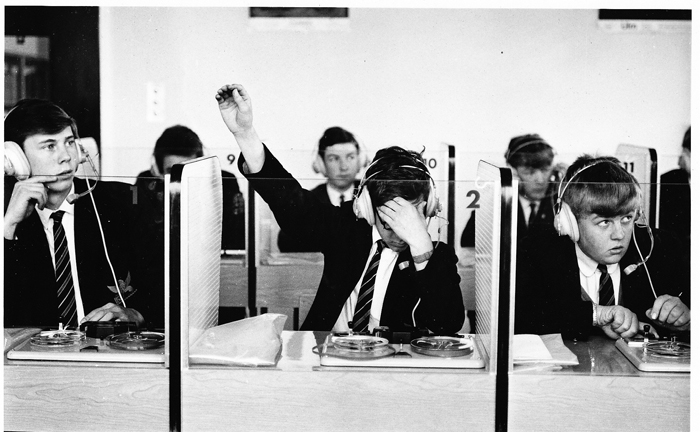Patrick Langley tunes in to the distortion of the recorded voice
The collaborative performance Boomerang, by Richard Serra and Nancy Holt, was originally broadcast live on Texas public television in 1974. I recently watched it on YouTube. Sitting in a blue TV studio, Holt narrates her immediate experiences of being recorded, while, at the same time, her own words are fed back to her via headphones with a one-second delay. As I watched the artist grimace and squirm, the work began to feel like a mildly sadistic speech exam. If the effect felt disorienting for me, I thought, it must have been sickening for Holt. Indeed, over the minutes that follow, the experience destabilises her sense of self and place. At one point, she gives us a paradox worthy of Shakespeare’s tragedies: “I am not where I am”.
The video reminded me of a moment in primary school when, one afternoon, a teacher sat me in front of a tape recorder. Encased in thick black plastic and as big as a shoebox, the machine looked sturdy enough to survive even the most destructive event – an earthquake, say, or a typical afternoon in a London state school. Finger hovering over the record button, she instructed me to recite a times table into a microphone built into its side. (Every student in the class was asked to do this, I can’t remember why.) Once I had done so, she rewound the tape and hit play. “Six,” said a voice on the crackly tape. “Nine.” Who was this impostor child, with his whiny, distinctly unserious voice? Surely he wasn’t me.
As Boomerang and the memory it triggered demonstrate, audio technology can have dissociative effects on self-image. Stripped of the lower frequencies that resonate in our head bones when we talk, our voices sound oddly high-pitched to us in recordings. The resulting estrangement explains why many people hate hearing themselves on tape. But to psychoanalyse my young self for a second, my discomfort may have had something to do with a deeper anxiety, which Boomerang brought to the fore: that my tape-recorded voice was an inauthentic replica, an acoustic doppelganger that sounded like – but wasn’t – me.
In contrast to tape, my first reactions to hearing my echo, naturally produced by cathedrals and multistorey carparks alike, were of joyous interaction with my environment. I shouted at the world – and it shouted back. According to the Roman poet Lucretius, echoes, which multiply the human voice, can evoke a sense of divine reach: ‘one word, / Sent from the crier’s mouth, may rouse all ears / Among the populace’. To disseminate a voice throughout a populace – to access citizens’ ears – has long been connected to the notion of political power. (Contrast this to Holt feeling mobbed by her own echo on public television: “I am surrounded by me”.) But according to Lucretius, there’s a flipside: echoes mock the speaker by turning their words into ‘phantoms’. Doomed to repeat the last syllables of whoever speaks at her, Echo, the cursed nymph of the Greek myth, retreats into a cave. Eventually, writes Ovid, ‘only her bones and the sound of her voice are left’. In this nightmarish vision, which the poet Anne Carson and others have read as a parable of patriarchal censorship of women, Echo’s voice outlives her.
For sound and video artists working around the time Boomerang was made, tape recorders, Sony Portapaks and TV studios offered new spins on this age-old sonic phenomenon and its attendant anxieties. Take Bruce Nauman’s 1969 video Lip Sync (also available online, should you want to spend an hour staring into an artist’s mouth). In it, Nauman films himself in closeup attempting, not often successfully, to sync his speech with a delayed recording of his voice. It’s a hypnotic demonstration of the unstable gap between self and self-image, body and machine, that for all its angst captures an off-the-cuff immediacy.
Today, technologies that record, repeat and multiply the human voice offer anyone with access to an iPhone the possibility of creating not just new audio recordings, but whole barbershop quartets of audio-doubled, speech-distorted selves. In her 2019 album, PROTO, the musician Holly Herndon pushed this further. She used custom-built AI software to create ethereal cyberchoirs using recordings of her voice and those of her collaborators (among them artist Martine Syms). These digitised phantoms rustle, gasp, arpeggiate and trill in ways no human could, revealing the rich expressive territory that opens up where voice is taken over by software. Rather than threaten the self, such technology expands it. In a noise-polluted age, to fuse your voice with a machine’s may be one way to ensure it reaches people’s ears.
Patrick Langley is a critic and novelist based in London
From the April 2020 issue of ArtReview
